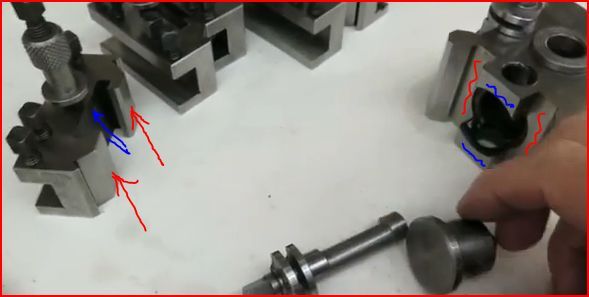Boxford have used that clamping arrangement on all of their lathes that I am aware of even my ME10 but both screws go in from the back. The cross slide bulges out where the compound sits. The metal thickness at above the holes looks similar. I've never heard of one cracking.
I would wonder if the crack was their when you bought the lathe. Putting the screw at the front like that seems to be a rather retrograde step as cutting forces will be acting directly on them. Maybe the plate can be swung round to prevent that.
The other reason it may crack could be down to well over tightening them. Don't know what is supplied with your lathe but mine has the hex key for them is on one end of the chuck key handle. They only need firmly nipping up as considerable force can be applied via the screw – put the 2 together, plate orientation the wrong way round and the compound slips – more tightening etc.. Crack.
Maybe the marks on the tailstock are down to metric screw cutting if it's an imperial lathe. I assume that on the metric version they supply the same type of screw cutting indicator as they do on the usual older Boxfords. It allows many of the pitches to be cut in the normal way by disengaging screw cutting at the end of the cut and winding back by hand. The choice of 1 of 2 gears on the indicator maintain sync with the thread.
I assume that the power feed is still the same so that wouldn't mark the tailstock badly. It's effectively a friction drive so that it can be run up against a bed stop. On the older lathes the drive is obtained via a slot that runs down the lead screw that drives a keyed bush. The friction level can be adjusted with a knob on my ME10.
I wouldn't think of welding to try and repair it. Cast iron isn't well know for welding well. I'd simply clamp firmly and add some straps to the outside. 6mm thick ms should be fine screwed and doweled or roll pinned to the edge. There is a sort of stapling method but it would need more space than you have. I've seen it used to fix large miller head castings – some one walked away and left the vertical power feed on.
 If you want to throw your dodgy QCTP away please use my dustbin. I'd say the problem is too much cam action and maybe incorrect material. Over time I suspect you wouldn't be able to get the screws out of the holders as the ends will bell out. Best fit high tensile screws.
If you want to throw your dodgy QCTP away please use my dustbin. I'd say the problem is too much cam action and maybe incorrect material. Over time I suspect you wouldn't be able to get the screws out of the holders as the ends will bell out. Best fit high tensile screws.
John
–
 Ady1.
Ady1.



 . Any slackness in the holding down bolts would also put it under extreme strain, especially in a dig in situation. Parting off on a lathe is the purest test of how rigid the machine is (I HATE it)
. Any slackness in the holding down bolts would also put it under extreme strain, especially in a dig in situation. Parting off on a lathe is the purest test of how rigid the machine is (I HATE it)

